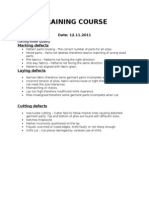Marker Modes
Marker Modes
Uploaded by
Gaurav ShakyaCopyright:
Available Formats
Marker Modes
Marker Modes
Uploaded by
Gaurav ShakyaCopyright
Available Formats
Share this document
Did you find this document useful?
Is this content inappropriate?
Copyright:
Available Formats
Marker Modes
Marker Modes
Uploaded by
Gaurav ShakyaCopyright:
Available Formats
LESSON 10: MARKER MODES
Objectives: Understanding the impact of fabric nap on marker planning Examine the role of symmetry and directionality of fabric
The form of the fabric and whether it is symmetrical and/or directional determine the appropriate type of marker for a style. Markers may be open or closed depending on the form that the fabric is presented for cutting. Rolled fabrics are open and flat when spread. Markers for this type of spread require pattern pieces for each part to be cut. Markers made with full-pattern pieces for each part to be cut. Markers made with full-pattern pieces are called open markers. Tubular knit fabrics are closed on both edges and therefore require pattern pieces that utilize the folds. Markers with half-pattern pieces for laying along the folds of the tube are called closed markers. Garment parts must be symmetrical if halfpattern pieces are used. Marker makers must also consider the symmetry (side-to-side) and directionality (end-to-end) differences in fabrics. Symmetric fabrics are the same side-to-side. Asymmetric fabrics such as border prints are different side-to-side. Non-directional fabrics are the same end-to-end. Directional fabrics are different end-to-end. Examples of directional fabrics include knits, n fabrics, and prints with flowers all growing in one direction. The marker mode is determined by the symmetry and directionality of fabric. There are three types of marker modes: nap-either-way (N/E/W), nap-one-way (N/O/W), and nap-up-and-down (N/U/D). In this case, the term nap is " to indicate the fabric is directional - it is different end-to-end. The nap of a fabric is created by its structure (corduroy or an unbalanced plaid), a finish, or a directional print. With symmetric, nondirectional fabrics, pattern pieces can be placed on a marker with only consideration for grain line. This marker mode is called nap-either-way (N/E/W). Pieces are placed for best fabric utilization. On some directional fabrics, such as corduroy, it may be possible for all the pattern pieces of one size to be placed in one direction and another size placed ill the opposite direction. This is called nap-up-and-down (N/U/D). With this type of marker, the nap of corduroy jeans may run down for a size 7 and up for a size 9. The critical factor is that the nap must run the same direction in all the pieces of one garment. Napped fabric such as corduroy will appear shaded if the pieces in one garment have the nap running in different
directions. Generally N/U/D will yield a better utilization of fabric than N/O/W. A marker is made for a specific style, fabric, and number of sizes. The length of the marker determines the length of the lay that will be spread. Completed markers are sent to the cutting room electronically or in hard copy for the spreading and cutting processes.
You might also like
- Fabric Specification Form: Please Refer To Pretest Guide For TestingDocument5 pagesFabric Specification Form: Please Refer To Pretest Guide For TestingHemel Khan100% (1)
- Signature 1940Document68 pagesSignature 1940denny whitson100% (1)
- Ripe Wheat Doily RunnerDocument3 pagesRipe Wheat Doily Runnerlessa_13No ratings yet
- Carr and Latham's Technology of Clothing ManufactureFrom EverandCarr and Latham's Technology of Clothing ManufactureDavid J. TylerRating: 4 out of 5 stars4/5 (1)
- Apparel Considerations For Clean ManufacturingDocument2 pagesApparel Considerations For Clean ManufacturingGaurav ShakyaNo ratings yet
- Dreamscape Pullover - Final - CrochetpdfDocument16 pagesDreamscape Pullover - Final - CrochetpdfRogan100% (3)
- Fabric Quality ControlDocument4 pagesFabric Quality ControlShazzad HossaInNo ratings yet
- Assignment-2 (S.P.M.E-2) : Cut Order PlanDocument13 pagesAssignment-2 (S.P.M.E-2) : Cut Order PlanAastha SinghNo ratings yet
- Export House PresentationDocument8 pagesExport House PresentationSantosh BishtNo ratings yet
- Assignment On RMG Related Industry in BangladeshDocument20 pagesAssignment On RMG Related Industry in BangladeshAsm Towheed100% (1)
- Garment Industry DepartmentDocument4 pagesGarment Industry DepartmentNidhi GargNo ratings yet
- Stitch TypesDocument3 pagesStitch TypesbawaneatulNo ratings yet
- Internship Report On Marchandising in Garments IndustryDocument47 pagesInternship Report On Marchandising in Garments IndustryHimuSunNo ratings yet
- Presentation-Slitting MachineDocument18 pagesPresentation-Slitting MachineMohammed HaseebNo ratings yet
- Warp and Weft Calculation Sheet 06-071Document1 pageWarp and Weft Calculation Sheet 06-071madhavendratiNo ratings yet
- Chapter 6 - Sample ApprovalDocument17 pagesChapter 6 - Sample ApprovalAminurNo ratings yet
- Lecture # 8 SamplingDocument9 pagesLecture # 8 SamplingwamohsinNo ratings yet
- Apparal Merchandizing and Sources Asif MangatDocument8 pagesApparal Merchandizing and Sources Asif MangatAsif MangatNo ratings yet
- Regenerated Fibres: ViscoseDocument16 pagesRegenerated Fibres: ViscoseAshfaque AhmedNo ratings yet
- ONLY Sample Consumption 1stDocument6 pagesONLY Sample Consumption 1stRejaalNo ratings yet
- Apparel Merchandising Azmir LatifDocument54 pagesApparel Merchandising Azmir LatifEleven withitNo ratings yet
- Cut Order PlanDocument4 pagesCut Order Planleosun halariNo ratings yet
- Inspection For Knitted Fabric 4 PointDocument1 pageInspection For Knitted Fabric 4 Pointtexcons6771No ratings yet
- VM Section 6 Technical Design Sample & Fit RequirementsDocument29 pagesVM Section 6 Technical Design Sample & Fit RequirementsobaidulaNo ratings yet
- Apparel Manufacturing Process: Assignment - 2Document17 pagesApparel Manufacturing Process: Assignment - 2ajay kalangiNo ratings yet
- Title:: Textile Testing and Quality AssuranceDocument5 pagesTitle:: Textile Testing and Quality AssuranceTauqeer RazaNo ratings yet
- Analysis of Garment W.R.T To Stitches and SeamsDocument10 pagesAnalysis of Garment W.R.T To Stitches and SeamsRehan SaeediNo ratings yet
- Overview of Textile IndustryDocument7 pagesOverview of Textile IndustryM.José Copons GalloNo ratings yet
- GSP HandbookDocument257 pagesGSP HandbookEddie BoyzNo ratings yet
- Topic:: International Islamic University ChittagongDocument15 pagesTopic:: International Islamic University ChittagongFiroz AhamedNo ratings yet
- Trainnig Material.Document32 pagesTrainnig Material.siraj kataleNo ratings yet
- ERP in Apparel IndustryDocument17 pagesERP in Apparel IndustrySuman KumarNo ratings yet
- Session 8 Calulating COST 2Document33 pagesSession 8 Calulating COST 2AlokKumarNo ratings yet
- Potential Reasons For Broken, Skipped or Missing StitchesDocument6 pagesPotential Reasons For Broken, Skipped or Missing StitchesgetNo ratings yet
- IntroductionDocument4 pagesIntroductionVikalp TomarNo ratings yet
- Amm 301Document58 pagesAmm 301asadshekhNo ratings yet
- GMTDocument22 pagesGMTEusha NightangelNo ratings yet
- A Short View of Textile FibresDocument17 pagesA Short View of Textile FibresRezaul Karim TutulNo ratings yet
- DNLSDocument4 pagesDNLSshrutiagarwal9229No ratings yet
- Assainment On Marker Making in Appral ManufacturingDocument8 pagesAssainment On Marker Making in Appral Manufacturingblokeyes0% (1)
- A&estitchseamdefectsDocument5 pagesA&estitchseamdefectsTee CeeNo ratings yet
- Garment Inspection ReportDocument5 pagesGarment Inspection ReportGourab MondalNo ratings yet
- Cutting Room Technology-1,3,4,5Document32 pagesCutting Room Technology-1,3,4,5Utsash SarkerNo ratings yet
- Merchandising Practice in Apparel IndustryDocument53 pagesMerchandising Practice in Apparel IndustryrafsanNo ratings yet
- Fabric Consumption For Woven Products (Basic Shirt and Trouser) 2. How To Prepare A Fabric Booking/order SheetDocument18 pagesFabric Consumption For Woven Products (Basic Shirt and Trouser) 2. How To Prepare A Fabric Booking/order Sheetaqsa imranNo ratings yet
- Textile Calculations and EquationsDocument1 pageTextile Calculations and Equationsarsh thakurNo ratings yet
- Garment Industry Departments and WorkingsDocument61 pagesGarment Industry Departments and WorkingsMUHAMMADLMNo ratings yet
- Tech Pack of T Shirt OrderDocument7 pagesTech Pack of T Shirt OrderZoya Febina MuhammedNo ratings yet
- Points To Be Noted, MerchandisingDocument1 pagePoints To Be Noted, MerchandisingRejaalNo ratings yet
- Sample PDFDocument4 pagesSample PDFmohsin alamNo ratings yet
- Knit Prod Dev ProjectDocument67 pagesKnit Prod Dev Projectshuvo792No ratings yet
- Weft Knitting Machine ProductionDocument1 pageWeft Knitting Machine ProductionAshraf Khan01No ratings yet
- 1b.understanding Quality Procedures in SAMPLING & Sample DevelopmentDocument15 pages1b.understanding Quality Procedures in SAMPLING & Sample DevelopmentNeetek SahayNo ratings yet
- Anti Treatment Knits PrintDocument22 pagesAnti Treatment Knits Printn.tNo ratings yet
- Session Defect Classification and Rating Areas - GarmentsDocument16 pagesSession Defect Classification and Rating Areas - GarmentsAdithya RamNo ratings yet
- Costing of Apparel ProductsDocument26 pagesCosting of Apparel ProductsRAHUL MNo ratings yet
- Lecture 7 (Week 4)Document19 pagesLecture 7 (Week 4)Mian MubeenNo ratings yet
- Chapter 5 Fabric PropertiesDocument21 pagesChapter 5 Fabric PropertiesNURUL ZAKIAH ZAMRI TANNo ratings yet
- Defects in GarmentsDocument2 pagesDefects in GarmentsAbul HasanNo ratings yet
- 1c. Cutting TrainingDocument1 page1c. Cutting Trainingjahazi1No ratings yet
- Marker ModesDocument6 pagesMarker ModesSumit KumarNo ratings yet
- Typs of MarkerDocument2 pagesTyps of MarkerarunkadveNo ratings yet
- 02 - FAD QuestionsDocument16 pages02 - FAD Questionsmaya_muthNo ratings yet
- A Guide in Laying Out PatternDocument3 pagesA Guide in Laying Out PatternShysytigre Rejolio SyNo ratings yet
- Making Things Better Competing in ManufacturingDocument243 pagesMaking Things Better Competing in ManufacturingGaurav ShakyaNo ratings yet
- India Strategic Overview by Shabbir GhadialiDocument46 pagesIndia Strategic Overview by Shabbir GhadialiKushal KhemkaNo ratings yet
- Marker EfficiencyDocument2 pagesMarker EfficiencyGaurav ShakyaNo ratings yet
- Method Time StudyDocument1 pageMethod Time StudyGaurav ShakyaNo ratings yet
- Materials HandlingDocument1 pageMaterials HandlingGaurav ShakyaNo ratings yet
- Lay Planning TypesDocument1 pageLay Planning TypesGaurav Shakya100% (1)
- Loading BundlingDocument1 pageLoading BundlingGaurav ShakyaNo ratings yet
- Marker PlanningDocument2 pagesMarker PlanningGaurav Shakya100% (2)
- Marker EfficiencyDocument2 pagesMarker EfficiencyGaurav ShakyaNo ratings yet
- Lock Stitch MachineDocument4 pagesLock Stitch MachineGaurav ShakyaNo ratings yet
- Lay Planning TypesDocument1 pageLay Planning TypesGaurav Shakya100% (1)
- Development and The Changing Dynamics of Global Production Global Value Chains and Local Clusters in Apparel ManufacturingDocument27 pagesDevelopment and The Changing Dynamics of Global Production Global Value Chains and Local Clusters in Apparel ManufacturingGaurav ShakyaNo ratings yet
- Textile and Leather Company ProfileDocument68 pagesTextile and Leather Company ProfileWendimu YitagesuNo ratings yet
- World S Greatest Magic Tricks Townsend Charles BarryDocument84 pagesWorld S Greatest Magic Tricks Townsend Charles BarrylanguequzeemNo ratings yet
- ClothingDocument138 pagesClothingjagan19790% (1)
- Mosaic Crochet Beanie PatterndDocument4 pagesMosaic Crochet Beanie PatterndChantal Korff100% (2)
- Catalogue African Style 2019Document9 pagesCatalogue African Style 2019Adam MalikNo ratings yet
- Abrasion Resistance MartindaleDocument3 pagesAbrasion Resistance MartindaleGreeshma100% (1)
- Activity in English 7Document3 pagesActivity in English 7Angel Nicolin SuymanNo ratings yet
- Oman Fruit HangerDocument48 pagesOman Fruit HangerhoneyfantasxNo ratings yet
- Women's Knitted Dress in Novita Nordic Wool DownloadableDocument3 pagesWomen's Knitted Dress in Novita Nordic Wool DownloadablePatricia Del CampoNo ratings yet
- Inside Crochet 90Document100 pagesInside Crochet 90Екатерина Матушинец100% (5)
- Cutting Processes Garment Industry EbookDocument22 pagesCutting Processes Garment Industry Ebookkarthikeyan100% (1)
- Challenges and Design Opportunities in Prototyping Seamless Knitted Apparel: A Case StudyDocument13 pagesChallenges and Design Opportunities in Prototyping Seamless Knitted Apparel: A Case Studytop 100No ratings yet
- Amigurumi Butterfly Free Crochet Pattern - Amigurumi Free PatternsDocument9 pagesAmigurumi Butterfly Free Crochet Pattern - Amigurumi Free PatternspamemgNo ratings yet
- Assignment On How We Can Increase The GSM of FabricDocument2 pagesAssignment On How We Can Increase The GSM of FabricZAyedNo ratings yet
- Free Baby Yoda 2023Document6 pagesFree Baby Yoda 2023tangthinamhuongNo ratings yet
- Stitch ClassesDocument47 pagesStitch ClassesBindu BasannaNo ratings yet
- 18 Homemade Christmas Decorations How To Make Christmas Decorations EbookDocument44 pages18 Homemade Christmas Decorations How To Make Christmas Decorations EbookDanijela Danchi100% (6)
- Amigurumi Animal PatternsDocument147 pagesAmigurumi Animal Patterns54kgvykzxwNo ratings yet
- Cow LoloDocument15 pagesCow LoloAndrea CordovaNo ratings yet
- My Favorite Ribbed Hat For Straight Needles - Clothing Knitted My Patterns - Mama's Stitchery ProjectsDocument1 pageMy Favorite Ribbed Hat For Straight Needles - Clothing Knitted My Patterns - Mama's Stitchery ProjectsLou BNo ratings yet
- Free Ebook FeltingDocument13 pagesFree Ebook FeltingTânia Brugni100% (1)
- Cable Scarf: Lisa RichardsonDocument2 pagesCable Scarf: Lisa RichardsonRoganNo ratings yet
- Pattern Crochet Hat and Mittens SimplicityDocument6 pagesPattern Crochet Hat and Mittens SimplicityClaudia PanteaNo ratings yet
- Wrap DressDocument17 pagesWrap Dresstasod96295No ratings yet
- Information Sheet For Applying Finishing Touches On Men's Casual ApparelDocument5 pagesInformation Sheet For Applying Finishing Touches On Men's Casual ApparelAngelica Tamio PorcionculaNo ratings yet
- WeCrochet Cold Snap ShawlDocument8 pagesWeCrochet Cold Snap ShawlTatu AradiNo ratings yet




































































































